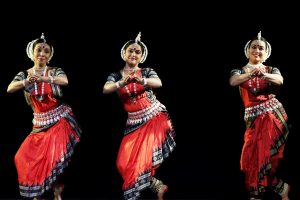United we stand
Pushpak Dance Academy has a heartwarming record of bringing productions of different dance groups or academies together. On 1 July, a packed Rabindra Sadan witnessed another such example of bonhomie featuring four extraordinary items
Sujata Mohapatra, Bimbavati Devi, Luna Poddar, Satyanarayan Raju and their likes danced their way into the hearts of the audience. The artists who performed on the two day festival on 7 and 8 January in the Satyajit Ray auditorium of ICCR in Kolkata were all veterans and stars in their respective fields. They perhaps could have added another dimension to the festival by including the young, who after all would be their torch-bearers.

photo:sns
2 023 has seen Darpani take the initiative of presenting the third edition of ‘Mardala Manjeera’ to connoisseurs and aficionados on the 97th birth anniverasary of legendary Guru Kelucharan Mohapatra, whose disciple is Arnab Bandopadahyay, the Artistic Director of Darpani. “In the 25 years of its existence, Darpani has made a mark in presenting to the world the rich heritage of the country”, said Bandopadhyay. A bunch of the choicest blooms from amongst the several traditional dance forms – like Manipuri, odissi, Bharatnatyam and Kathak – in all their fragrance was presented.

Advertisement
Sujata Mohapatra, Bimbavati Devi, Luna Poddar, Satyanarayan Raju and their likes danced their way into the hearts of the audience. The artists who performed on the two day festival on 7 and 8 January in the Satyajit Ray auditorium of ICCR in Kolkata were all veterans and stars in their respective fields. They perhaps could have added another dimension to the festival by including the young, who after all would be their torch-bearers.
Advertisement
Team Darpani presented ‘Krishnakatha’ and ‘Shibshakti’, thus embracing two of the Trinity of Sanathan Dharma. Soumen Chakraborty’s and Khokan Prasad’s light and sound gave the show a fullness. In Krishna Katha, Arnab danced in a group with his students in keeping with the guru-sishya-parampara. The pieces included in Krishna Katha were “Srita Kamala” from the Geet Govinda, “Nachunti Range”, an Ananda Tandava dance with the gopis, and a Pallavi in raga Patadeep.

The presentation of Shiva Shakti was a spiritual uplift as it showcased the union of Divine Consciousness and energy. ‘Abhisarika’ – an abhinaya piece based on the lasya style of Manipuri dance was on the pet theme of anxious and desperate Radha craving to meet her beloved Krishna. Stepping out on a dark stormy night would have its own pitfalls. Innovative “Vyakula Radha” rehearses and practices overcoming these impediments. It was a composition of Guru Bipin Singh which was given a new look by Bimbavati Devi, to the music of N. Tiken Singh and Suman Sarkar. Poong was played by R.K. Upendro with vocal support by M. Priyarani Namah Krishnaya revered the ultimate Saviour Krishna. He is at once the preserver and nurturer of mankind. Shree Bhagawan had himself proclaimed that whenever there is an ominous probability of good being trampled by evil, He will renounce his hiatus and destroy the evil with His power and panache and protect His devotees. He is again the one who entices the maidens who yearn to be with Him.

He is Gopala, the one who playfully tames his cattle. Namah Krishnaya is an obeisance to the Lord of all senses. Choreography was by Bimbavati Devi and the music was composed by Guru Kalavati Devi, N. Romila Devi and Bimbavati Devi. Rhythm arrangement was R.K. Upendro Singh’s. Bharatanatyam exponent Satyanaryana Raju regaled the audience with a Varnam about Krishna. “Sri Krishna Kamala Naatho” dealt with Verses of Krishna Karnaamrutha Shloka compiled together in the format of Varnam, glorifying the greatness of Lord Krishna through his different leelas. Infant Krishna sucking the life out of Poothana, the demoness who went to Gokula intending to kill him, but got moksha instead and He is the Master who shows the path to Arjuna in the battle of Kurukshetra. Here Krishna gave to the world The Geetopadesha and shows his Vishwaroopa darshana.
Raga Reethigowla provided melodious music. Conceptualised by Acharya Sri Raghavendra J Prabhat to the music composition of Vidwan Sri Tirumale Srinivas, the dance was composed by Guru Smt. Narmada. Bhajan, Bhajamana Rama Charan Sukhadaayi Rama – a Tulsi Das Bhajan – genuflected to the Divine Feet of Vishnu’s incarnation. The sanchari of the dance depicted the touching episode of Bharata’s ardent request to his brother to rule Ayodhya, but returns devoutly with his ‘paduka’ to be placed on the throne and Bharata continues to rule till the return of his brother. Bhakti bhava of Kevat, the boatman who washed the feet of the Divine soul, was a poignant presentation in the aesthetic beauty of Bharatnatyam. Raga Sindhubhairavi and Taala Aadi added to the quality rendition of the bhajan. Homage to Sri Jagadeeshwari Durga in all its aspects in Raga Ahiravairabhi was a connoisseur’s delight. It was by Sri Lalgudi G Jayaraman.
Sujata Mohapatra, one of the very talented disciples of Guru Kelucharan Mohapatra, has mastered the art of presenting the learnt lessons aesthetically. Her worth lies in the fact that she is at the present moment the most sort after performer. After Guru stuti she silenced the audience with the beauty of her pure nritta. Hamsadhwani Pallavi was followed by ‘Sakhi hey’ from Geet Govinda pleading with her Sakhi to fetch her lover Krishna to her. Ardhanariswara, the masterpiece work of Guru Kelucharan Mohapatra was the grand finale of her recital, where the portrayal of both the feminine and masculine quality in one body to Shankaracharya’s Shloka ‘Champeya Gourardha” was danced with elan. Kathaka Luna Poddar of the Lucknow gharana Kathak showed her adeptness in the nine matra taal. “Nagendra Haraya trilochanaya” was a naman to Shiva through the panchakshara stotram.“Pia tore kaise abhiman” was emoted succinctly.
(The reviewer is a senior dance critic)
Advertisement